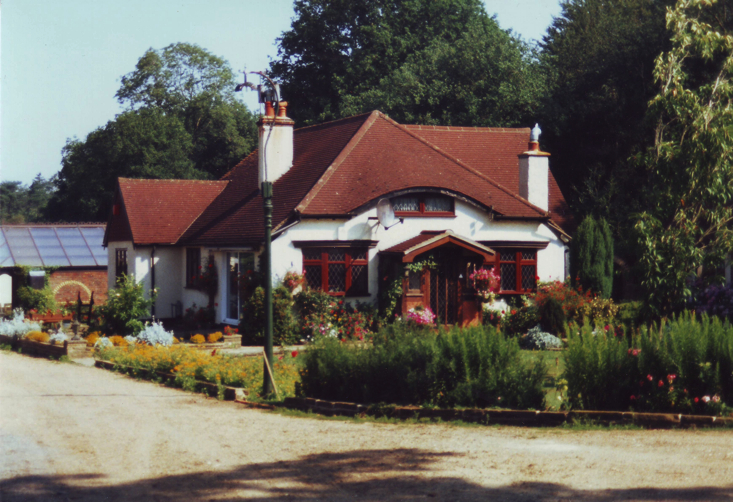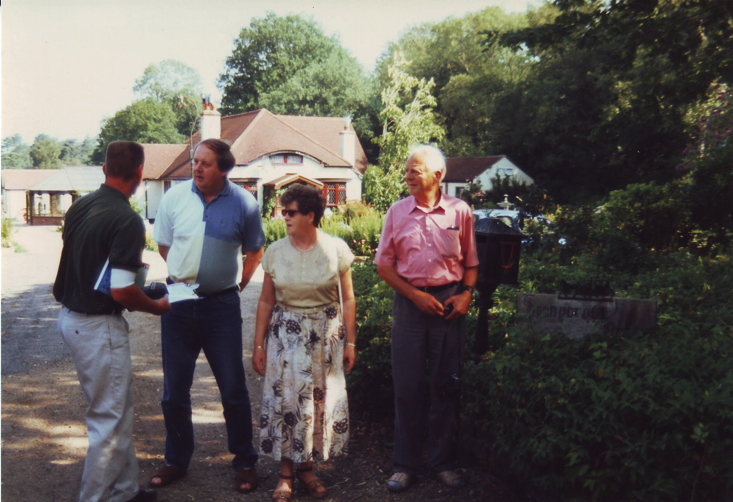Date: 18th August 1940
Time: 1.20 p.m.
Unit: 9 Staffel/Kampfgeschwader 76
Type: Dornier Do 17Z-2
Werke/Nr. ?
Code: F1 + HT
Location: (Sunnycroft) Golf Road, Kenley. Kent.
Pilot: Feldwebel. Johannes Petersen (Born 18.06.1914 – Killed.
Observer: Oberleutnant. Hans-Siegfried Ahrends (Born 03.01.1915 – Killed.
Radio/Op: Unteroffizier. Karl Greulich (Born 29.06.1911 - Killed
Gunner : Feldwebel. Hans Dietz (Born 01.04.1916 – Killed.
Oberst. Dr. Otto Sommer (Born 22.10.1891 – Killed.
REASON FOR LOSS:
This aircraft was hit by A.A. defences during low level attack on Kenley aerodrome, crashed in flames on a bungalow known as "Sunnycroft" on the perimeter of the airfield. All five members perished in the aircraft.
Markings: originally F7 changed to F1+HT, H is in yellow. Manufactured by Blom and Voss under licence from Dornier. Works No. 334/-035 LMB. Engines: Bramo 9-cylinder radial. Airscrew VDM Frankfurt-Hidderheim, made in Hamburg Gross-Borstel.
Armament: only one gun traced, the rest were under the debris of a house which was hit. Three 50 kg bombs were found in the wreckage, although some bombs were dropped on target. Five 50 kg bombs were found lying in the garden of house opposite.

One of the Dorniers engines lies amidst the rubble of the small cottage "Sunnycroft"

Fuselage section seen here under guard.

Family death notice for Hans (Ahrends) ccc
ccc
Oblt. Hans Siegfried Ahrends (via Ahrends)  ccc
ccc
Personal account of the raid on Kenley by Ralf von Pebal of the 9th Staffel/KG76
On the early morning of 18 August we drove to the airfield in preparation for a low level mission against England. Gradually our friends and comrades arrived. There is great tension. After a departure delay of one hour we took off. Oddly, each of us has the uncertain feeling that today not everything will go smoothly. Little Leutnant Bittmann is the only one who voices that “Today there will be a great ass tearing between us and the English.” (The statement is written in Bavarian slang)
At 13:20 we took off, all nine aircraft of the 9th squadron. The tactic is as follows: The Ju88s of the 2nd group will lead with a dive bombing attack, then the Do's (Dorniers) of the 8th staffel will drop their bombs. We are to conduct a low level attack against the target. The entire operation is to take place under a strong fighter escort. We cross the coast and descend low over the Channel and keep watch for fighters. Haze lies over the water, droplets stream from the cockpit windows. Soon the quiet will end. We see the coast shimmering through the fog, ascend a few meters higher and then the English coast becomes clearly visible and very close. I photograph what I can. 600 meters to the left are too early warning boats which we leave alone.
They signal us and when we don’t reply we assume they are sending a radio report notifying their Flak batteries of uninvited guests. We are already over steep cliffs. Now it can begin. We are buzzing along at 300 kilometers per hour at an altitude of 5 meters over English countryside. Every terrain elevation provides us with cover, every forest is used as concealment. We leap over trees, it is a continuous movement up and down movement. I see no Flak emplacements. An express train passes under us and is gone, a pair riding bicycles takes cover in a ditch as if they were in basic training. Over parking areas, mansions, and castles, over factories and soot darkened workers’ houses we race past. Those that see the Balkan Cross on our wings are gripped by panic. Slowly we lose our section leader, the formation is disintegrating. There…..an airfield. The last fighter has lifted off the ground and now the English are flying a
wide curve to come up behind us….
…as our bombs land and explode. A Spitfire hangs on the aircraft to our right and will not be shaken off. I watch as the tracers are exchanged between the two aircraft. Our radioman fires. A fighter closes from behind- my photography long forgotten. The fighter grows larger while the radioman exchanges one ammunition drum after another. I see the flashes of light from the Englishman’s wing. They are his cannons and machine guns. In our aircraft the noise is powerful. My foot receives an insane blow. I am convinced that I have been hit. I discover a hole in my boot and continue shooting. There, he is hit. A lucky shot took care of the fighter and suddenly he crashes into a wood. Already he has disappeared from our eyes.
I watch as our radioman gasps, puts on a steel helmet with shaking hands and fits another ammunition drum on the machine gun. Suddenly a loud noise, that drowns out the sound of the engines and shatters the canopy. Immediately I think of a Flak hit. As I look to the rear I see a leafless and half torn tree disappear from view in a hollow. In the middle of England we have scraped a tree. Beneath us are houses, a collection of mansions before London. Two more times we must defend against fighters. We have long since departed on the way home. We notice, that something is wrong with the aircraft. Often the observer up front shoots at Flak positions. Several seconds later we are past. Now the radio operator fires to the rear as the target quickly passes by. Finally we are at the coast. The fighters are gone and we see nothing of our comrades. Barely are we over water when the left engine begins to fail and then stops. The oil tank has been hit and its contents have run out. We sweat blood. Slowly the aircraft drags itself onward. With one engine it pulls to the side. One looks at the other’s eyes to read their thoughts. The steel helmet bites into our necks, the hair clings to our foreheads, our blood races, the sweat is running in streams over our faces and dropping from our chins.
We still have not crossed halfway over the Channel. Anything, as long as it doesn’t mean ditching in the pond. None of us have the desire or strength to paddle now. The coast is 30 minutes away. Will we make it 20 minutes with one engine? We try to start the second engine but the cylinders are frozen. The remaining engine pulls horrendously to one side. The pilot must use his entire weight to offset the drag. We are prepared to use the rubber boat. It is clear to everyone that the likelihood of escaping the aircraft before it sinks is more than slim. Everyone is stressed. The aircraft climbs a little, slowly, then drops again. Thankfully the coast is near. We crab to one side, the tail droops and we gain a bit of altitude.
There is an elevation to our front. Our pilot decides to try flying over it. We barely make it and then are over a plateau.
Near Abbeville our Feldwebel pilot experiences an arm cramp. A place for an emergency landing is sought. We think we have found one. I put on the steel helmet, now a crash-helmet and press my head against the bulkhead and hold fast with legs and arms. The landing gear is not lowered; only a belly landing can save us. The tension mounts, I hear the grain brushing against the aircraft, or is it only the wind rushing around the stopped engines? A loud noise. I close my eyes. Is that all? Now a feeling of floating on the air, then a stupendous noise, a grinding and rending all around me. I am gripped by a massive fist and pulled forward and down. In the same moment smoke is in the aircraft and a dust cloud makes breathing impossible. For a moment all is quiet, then everyone moves to exit the aircraft. The escape hatch is stuck. If only the aircraft does not begin to burn. Three of us press against the roof of the aircraft. With a loud roar the hatch gives way. Now we are outside, our small flight engineer has injured both knees, but the fantastic flight has finally ended.

During August 1996 Melvin Brownless, Mike Croft & Matthew Johnson took the Ahrends family to the the crash location of their loved one Hans-Siegried Ahrends. Afterwards the family were driven to the German Military Cemetery at Cannock Chase to pay their respects to all four members of the crew who lost their lives. It was a very moving day for us all.

Melvin Brownless in conversation with the Ahrends family at "Sunnycroft" From left to right: Melvin Brownless, nephew Hans Siegfried Ahrends, Frau Ahrends and surviving brother of Hans
Burial details: Deutsche Soldatenfriedhof Cannock Chase; Block 5, Row 3, Graves 66-70
Researched by Melvin Brownless & Mike croft, Matthew Johnson, Udo van den Brock (1996) With special thanks to the Ahrends family and Dave Kirby for translating the personal account of Ralf von Pebal (March 2011)
